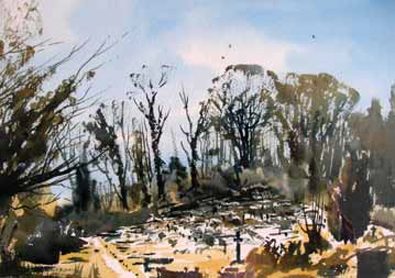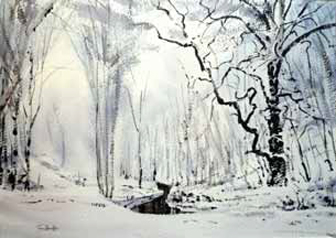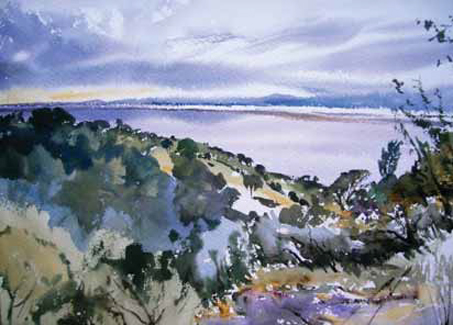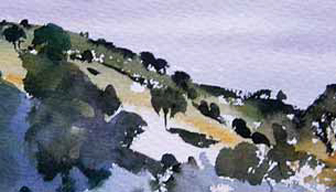
Have you tried painting en plein air? Were you put off by practical difficulties or some early bad results? PA Jem Bowden encourages you to climb the learning curve.
Working outdoors ‘from life’ will give you distinctly different results to working in the studio from secondary source material.
Visually different, but perhaps more potently to the artist, it will also feel different, having a quality of extra ‘authenticity’ as well as ‘memento’ value. It gives the satisfaction of having truly experienced a place and reacted directly and honestly to it in a visceral sense.

‘Rooks over Arnos Vale Cemetery’ – A fine autumn day gives an atmospheric low sun, here creating silhouettes of the sparsely-leaved trees. Light reflects strongly from the damp grass and gravestones. The tones are either very light (untouched white paper) or very dark, with not a lot in between.
You stand proudly by the result and say “that place, at that moment, made me do this”. And, although we are heading into winter, this time of year brings with it some of the most rewarding colours and tones, and perhaps less rain than our summer months! Any keen walker, wildlife enthusiast or amateur naturalist will find ‘en plein air’ a rewarding experience for more than painting, and you will likely produce your most inspired work.
Keep a list of things to pack, check and do before each excursion. Preparation is key, as is accepting those things beyond your control.
The weather
Don’t wait for a ‘perfect’ forecast. Drying paints are a battle on hot days, as much as slow-drying paints on cool or humid days. Take a small water spray to keep your palette damp when necessary. Use a more heavily-sized paper (eg Arches) on a dry day too – the water soaks into the paper less quickly giving you more working time before it dries.
The weight you’re carrying
Keep it down, or you’ll be put off the whole thing immediately.
Dog walkers and ‘interested’ people
You need focus and concentration to produce good work. Once paint is being applied you must remain absolutely in the moment. Dogs off leads can prove to be destructive, and interested onlookers fatally distracting. There are many virtually unused footpaths close to us all – get an OS map and find a hidden gem.
Sunburn/insect hassle/hay fever
An antihistamine pill and insect repellent spray are essentials for me, and I even pack a tiny ‘tick remover’ having learned the hard way!
Hunger and thirst/slight hardships/toilet!
The knowledge that you’ll have several paintings at the end of the day should get you through a few minor discomforts. Learning where the nearest pub is in relation to where you’re going can be useful. I tend to sip from my painting-water supply bottle when really needed.
Clothing
Take a cap or hat with a peak for working towards the sun. Wear quick-drying clothes rather than carry waterproofs, and footwear for the worst. With the walking and carrying I find I am usually more than warm enough all day in Summer, though fingerless gloves and scarf are useful the rest of the year.
Working environment
I sit on the ground on a thin plastic sheet. It protects against wet ground and thistles and weighs nothing. I lay all my materials in front of me within easy reach. You may prefer to use an easel or a lightweight artists’ chair with a table attached – see what works best for you.
Grass seed in your palette
Yep – inevitable!
Cows/horses
Don’t ever sit in a field with these! I have had to move sharpish and had brushes crunched up by inquisitive animals.

“Brislington Brook, January” Painted on an easel – very hastily! This was close enough to where I live to get it done before my hands fell off.
Your subject:
Don’t be too picky, or you’ll never start. Get on with it and you’ll realise that a vital painting can be created from almost anything. Avoid popular places and you avoid distraction. Well known, supposedly dramatic or picturesque scenes often disappoint in reality, and can inspire hackneyed images.
Composition
Simplify. Choose a focal point, and imagine the rest effectively out of focus. Don’t try to paint everything in a panoramic view. Use whatever strikes you first or hardest – whatever most conveys the ‘sense of place’. Use artistic licence to include and exclude. As the painting progresses allow any compositional element to change for the overall good of the image. I tend not to draw much initially, to aid this.

“Across the Severn from Walton Common” – a photograph
Taken with a wide-angle lens this photo still failed to contain the view that I was able to compose by being in situ. It was an overcast day, with fleeting gaps in the cloud allowing relative brightness to shine through only intermittently. I know I would not have felt inspired to work from this photo later in the studio.

“Across the Severn” -painted en plein air.
Far more detail can be seen when working from life, which can be enhanced in your painting, in this instance the distant mountains of Wales, barely visible in the photograph. I observed everything intensely when the sun came through, almost ceasing to paint for those moments whilst memorising the position of shadows. I worked much of the painting without any shadow or light at all, then brought it to life in a final stage by adding a bold wash of blue-y green over much of the painting where the dim sun had cast it’s shade. In addition there are a couple of crucial shadows from individual trees in the sunlit mid-ground (see detail below) creating a focal point.

Accurate basic shapes are painted quickly in just a few strokes, with little detail.
Note the combination of very light background wash with much darker tones on top to enhance the (in reality rather fleeting) effect of light in this area of the painting.
Capture atmosphere rather than detail. Observe well the light effect (cloud and shadow positions, haziness, silhouetting). You need to remember this as it will change, and light effect is the one factor you should NOT attempt to change halfway through a painting – never chase the light! Note areas of darkest and lightest tone – if facing towards the sun you might notice this more than any colour variation. Whatever the truth it should be there in your painting – don’t paint the grass dark green if it seems…pale yellow-ey grey. Paint fast and boldly, with commitment, and disregard for the odd technical glitch.
Stop at the earliest sign of uncertainty about whether the painting is finished. This can come far, far quicker than you were expecting. The ruination of much good work is preceded by the phrase “I’ll just add…”. Time to pack up and walk on to discover the next location…
If you find the time of year just too cold to make your hands work properly, use it as a time to walk and observe and learn how to recognise a potential subject – wherever you may be.
Think portable:
Jem is available for demonstrations in the Bristol area. To enjoy more of Jem’s paintings and to contact him visit www.saa.co.uk/art/jeremybowden or phone 07941 712674.